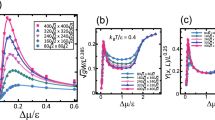Abstract:
Facetting of a vicinal surface is due to an arrangement of parallel primary steps which is commensurate with the substrate in plane periodicity (for instance one step every pth atomic row). It was shown by [#!Grempel!#] that such a locking requires an interaction between steps together with a finite step stiffness. But this early approach only reveals part of the story, as it is limited to sharp solid-vacuum interfaces in which thermal excitation of energetically expensive kinks controls all fluctuations. In this paper the problem is taken afresh in a language which applies equally well to “soft” interfaces, with important changes in the conclusions.
Similar content being viewed by others
Author information
Authors and Affiliations
Additional information
Received 26 June 2001
Rights and permissions
About this article
Cite this article
Nozières, P. The roughening transition of vicinal surfaces. Eur. Phys. J. B 24, 383–386 (2001). https://doi.org/10.1007/s10051-001-8687-0
Issue Date:
DOI: https://doi.org/10.1007/s10051-001-8687-0




